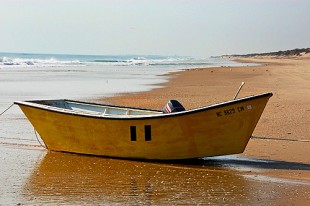
NC – The Outer Banks
 The North Carolina coast includes the famous outer banks as well as a serious of barrier islands, many of which are uninhabited and populated with wild Horses. From the “Graveyard of the Atlantic” to Cape Fear, the coastline has a dark history of shipwrecks and pirates like Blackbeard , who made their fortune pillaging these sunken ships. This area is the birthplace of Virginia dare, a child born in England’s first American colony now referred to as the Lost Colony due to its mysteriously disappearance.
The North Carolina coast includes the famous outer banks as well as a serious of barrier islands, many of which are uninhabited and populated with wild Horses. From the “Graveyard of the Atlantic” to Cape Fear, the coastline has a dark history of shipwrecks and pirates like Blackbeard , who made their fortune pillaging these sunken ships. This area is the birthplace of Virginia dare, a child born in England’s first American colony now referred to as the Lost Colony due to its mysteriously disappearance.
The cold northern labrador current meets the warm gulf stream off the coast of Cape Hatteras. If there is a storm in the Atlantic, chances are there will be a swell on one of the OBX (outer banks) beeches. With the continental sloop only a few miles form the shore, the waves pound the beaches with enough energy to regularly shift sandbars, destroying roads and creating new inlets. It is no wonder so many surfers move to these remote islands where the jobs are so few. Ask a local surfer why he wouldn’t choose balmy Florida, he might answer, Florida has oranges, North Carolina has tubes.
The most eastern point in NC is Rodanthe, home to the famous break S-Turns. Rodanthe and north, capture all the swell coming from east and northeast. Bending around the Cape brings you to Frisco which captures east and southeastern swell. Here the water can be 20 degrees warmer than just a few miles up the road by virtue of the gulf stream.
Continuing south from Frisco requires taking a ferry to arrive at Ocracoke. Wild Horses roam the sound side of this remote island, while 16 miles of pristine undeveloped beaches line the atlantic side. You will not run out of empty surf spots on Ocracoke. Like Frisco these beaches require a southeastern swell and miss out on some of the northern swell. You can stay in the quaint fishing village of Ocracoke at the end of the Island. It’s few pubs offer great craft beers and references to Blackbeard are everywhere.
From here you can either return to the mainland via a ferry to Cedar Island Bay or for the those looking for an even more remote breaks, a ferry will take you to the north core banks of Cape Lookout National seashore. You are now entering the lower or southern outer banks (SOBX) which includes 56 miles, (90-km) of protected beaches on the north and south core banks and another 8 miles on Shackleford banks. At the beginning of the north core banks you will find the ghost town of Portsmouth, created in 1753 and abandoned in 1971. The north and south core islands offer rustic cabins to stay in for the night. Shackleford is home to wild horses and has no manmade structures other than a lighthouse. While you can explore sections of these islands using the ferry service and a car with four wheel drive, to stake claim to a new secret surfing spots a reliable boat would come in handy.
Leaving the SOBX brings you to the Chrystal coast. These beaches, known for their white sand and emerald water, require a southeastern swell for there to be any surf. Further south, however, the beaches of Topsail, Lee Island (undeveloped boat access only), Figure eight (private), Wrighstville, Masonboro(undeveloped boat or paddle access only) and Carolina/Kure/Ft Fisher, also capture eastern swell and offer good surfing, though not as powerful as the outer banks. The beaches south of cape fear river face due south and therefore miss out on both northern and eastern swells. The surf becomes far less consistent from this point south as the coastline moves further from the continental shelf until Florida where it reaches its closet point to the shelf in West Palm Beach.
Due to the remote nature of so many of the North Carolina beaches gay life is not something you would expect to find.
The progressive port city of Wilmington in southeastern North Carolina, however, could be described as a gay friendly oasis on the southern coast. This college town is home to the largest US film production facility outside of California. It’s historic downtown has two officially gay bars and one club along with many gay friendly venues. The city also organizes a pride week every year and the occasional weekly takeover events where a group of gay men meet at a downtown bar or restaurant.
Further north, the local gay community on the outer banks has been actively marketing to gay tourists and have even created a web site: www.thegayobx.com, which helps organize a pride festival every summer.
DIRECTIONS
Coquina Beach, considered by locals to be the loveliest beach in the Outer Banks, is located off highway 12 at milepost 26, 8 miles south of Nags Head, North Carolina. One on the Outer Banks, take the bypass past all the crap in Kitty Hawk, Kill Devil Hills, and Nags Head to Whalebone Junction.
Go South from Whalebone Junction (you are now officially in “South Nags Head”). Continue approximately 10 miles on the beach road past mile post 25 and watch for the National Seashore Coquina Beach” sign.
Parking is in the public lot.
There are shopwers and bathrooms (cool).
GAY
It has been a long tradition among the Outer Banks local gays to have a beach party at Coquina Beach most Sundays during the summer months. Back in the 1970s and ’80s the Lost Colony actors congregated at the north end of Coquina Beach at the ranger station. Sunday was the natural choice since the Lost Colony didn’t play on Sunday evenings. A powerful nor’easter blew through in the late 1980s and covered the parking lot there in very deep sand. This forced “the colony” to move to the south end of Coquina. The local gays, including some colony folk formed a group called “The GLC” in the early 1990s and at it’s high point around 150 gay and lesbians gathered here on summer Sundays. Around the turn of the millenium some key members of the GLC moved away and the group stopped coming. Your friends here at TheGayOBX.com have revived this long standing Sunday tradition starting this past summer of 2009. We decided to return to the north end of Coquina for it’s feeling of isolation, more beautiful dunes and there’s a sheltered deck here with picnic tables between the parking lot and the dunes. Start your vacation by joining us every Sunday afternoon. Since this spot is somewhat isolated from the lifeguarded area further south, feel free to hang out here any day of the week. Coquina Beach is located across highway 12 from the Bodie Island lighthouse, just south of South Nags Head. Park in the last parking lot on the north end near the sign that says, “The Sand Castle”. Our beach is just over the dunes from the sheltered picnic tables., be sure you are in the parking lot that has the wind turbine. If it’s raining check this website for alternate plans. Click here for a direct link to our map for the Coquina Beach location.

